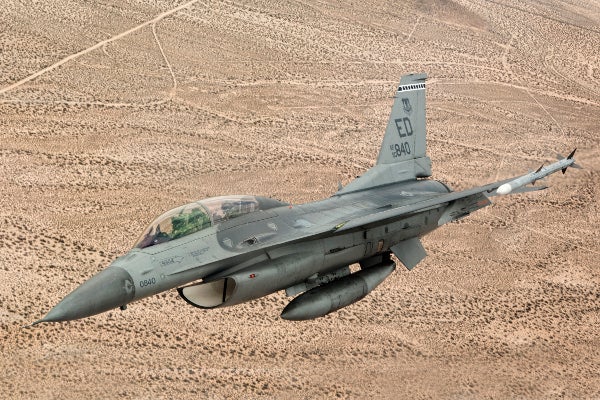
The US Air Force (USAF) is conducting a flight test of the automatic ground collision avoidance system (Auto GCAS) onboard an F-16 fighter to help ensure its integration into the fourth generation aircraft.
Conducted by 416th Flight Test Squadron team members at Edwards Air Force Base in California, US, the testing forms part of the flight trials phase of the Air Force Research laboratory’s (AFRL) Automatic Collision Avoidance Technology/Fighter Risk Reduction Program (ACAT/FRRP), on the F-16.
"The Auto GCAS was not only designed to prevent controlled flight into terrain CFIT, but to not interfere during normal F-16 operational maneuvers such as strafing missions and low-level flights," said Jessica Peterson, 416th FLTS flight dynamics lead.
Auto GCAS is a software-based technology designed to help pilots avoid CFIT mishaps by automatically implementing recovery manoeuvres without their intervention when terrain impact becomes imminent.
The system combines global positioning system (GPS) data with digital terrain elevation data (DTED) maps to help aircraft reference terrain below when it is flying closer to the ground.
Automatic recovery involves an abrupt roll-to-upright and a nominal 5-g pull until terrain clearance is provided, and can be stopped at anytime by the pilot.
How well do you really know your competitors?
Access the most comprehensive Company Profiles on the market, powered by GlobalData. Save hours of research. Gain competitive edge.

Thank you!
Your download email will arrive shortly
Not ready to buy yet? Download a free sample
We are confident about the unique quality of our Company Profiles. However, we want you to make the most beneficial decision for your business, so we offer a free sample that you can download by submitting the below form
By GlobalDataKyle Schlappi, 416th FLTS Auto GCAS project test pilot major, said the Auto GCAS will serve as final safety net in case a pilot unknowingly puts the aircraft in danger of hitting the ground.
"Once AGCAS is fully fielded, I imagine we’ll see an abrupt decrease in fatal F-16 accidents as the CFIT rate drops to nearly zero,” Schlappi added.
The technology is scheduled to be fielded on USAF’s 640 Block 40/42/50/52 F-16 fleet by 2014, with an aim to save the existing 14 F-16 aircraft and ten personnel with the service, as well as $530m over the F-16 future life.
Image: A US Air Force’s F-16D aircraft during Auto GCAS flight testing at Edwards Air Force Base in California, US. Photo: courtesy of Chad Bellay/Lockheed Martin.







